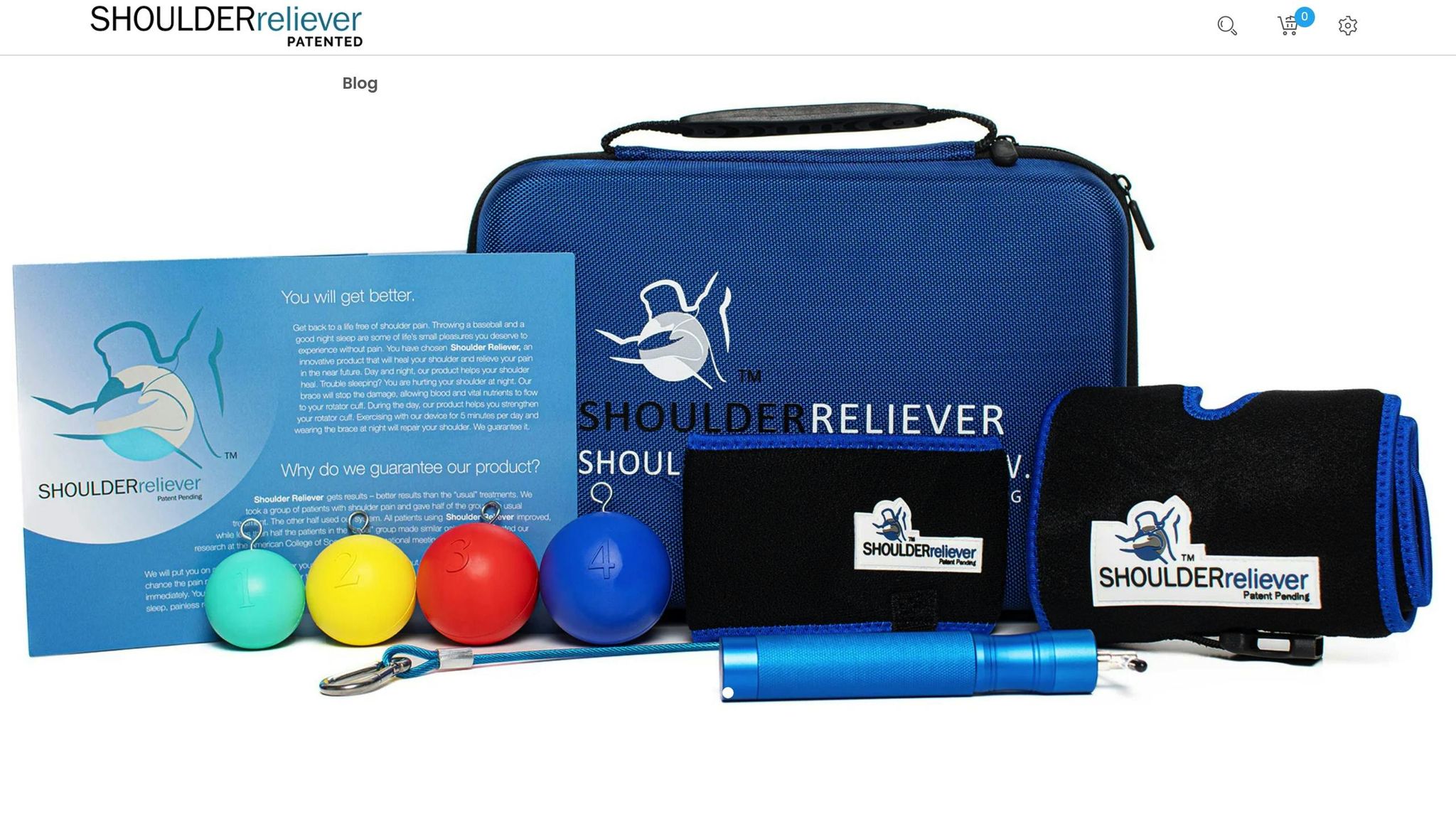
Night Shoulder Pain: Common Causes and Solutions
| Doctor Carroll
Nighttime shoulder pain is a common issue that disrupts sleep and worsens over time if untreated. It often stems from conditions like rotator cuff injuries, bursitis, or even frozen shoulder (more prevalent in people with diabetes). Poor sleep positions, inactivity, and inflammation can amplify the discomfort. Here's a quick overview of what you need to know:
- Main Causes: Rotator cuff tears, bursitis, frozen shoulder, biceps tendinopathy, and poor posture.
- Triggers: Sleeping on the affected side, staying in one position too long, and nighttime blood flow changes.
- Relief Tips: Adjust your sleep position, use pillows for support, try gentle stretches, and apply ice for swelling.
- Treatment Options: Physical therapy, the RICE method, regenerative treatments like PRP, or structured programs like the SHOULDER Reliever System.
Takeaway: Addressing the root cause with better sleep habits, targeted exercises, and early treatment can significantly reduce pain and improve your quality of life.
Keep reading for detailed solutions to ease your discomfort and sleep better.
Main Causes of Night Shoulder Pain
Rotator Cuff Issues
When you lie on your shoulder, it puts pressure on a rotator cuff tear, leading to more inflammation and stiffness. This pain often becomes worse when you try to lift your arm overhead.
Common symptoms include sharp or aching pain with movement, muscle spasms or cramps during sleep, and numbness or tingling sensations. These tears can also contribute to other problems like bursitis or frozen shoulder.
Shoulder Inflammation
Bursitis
This occurs when the bursae - small fluid-filled sacs that cushion the shoulder - become inflamed. Pain tends to intensify at night, especially if you lie on the affected side.
Frozen Shoulder
Also called adhesive capsulitis, this condition restricts shoulder movement and causes persistent pain, particularly at night. It affects 3–5% of the general population but is more common (up to 20%) in people with diabetes. It typically develops between the ages of 40 and 60, as the shoulder capsule tightens and limits motion.
Other Possible Causes
Biceps Tendinopathy
This refers to inflammation of the biceps tendon, which can result in a dull ache in the front of the shoulder.
Poor Posture and Sleeping Position
Slouching or sleeping directly on your shoulder can reduce blood flow and compress the joint. This often worsens inflammation and pain.
Work-Related Strain
Jobs that involve overhead movements or long hours at a desk can create muscle imbalances and tension, which may flare up at night.
The next section will dive into how sleep positions and inactivity can make these pain triggers even worse.
Nighttime Pain Triggers
Sleep Position Effects
Sleeping on your side puts direct pressure on the shoulder joint, which can strain tendons and the bursa. This position also rotates the arm inward and reduces blood flow, making pain worse during the night.
Staying in one position for too long can add to the discomfort.
Nighttime Inactivity
When you're still for extended periods, blood flow slows down, inflammation lingers, and morning stiffness becomes more likely. This lack of movement makes the shoulder more sensitive to pain during the night.
Pain Perception at Night
At night, the body's natural healing processes increase blood flow to inflamed areas, which can heighten discomfort. Fewer distractions and the effect of gravity on tendons make pain signals feel more intense.
Recognizing these triggers can help guide efforts to find relief.
Pain Relief Methods
Best Sleep Positions
Adjust your sleeping position based on your injury and how you normally sleep.
- Back sleepers: Place your injured arm across your stomach with a pillow under your elbow. This slight lift can reduce joint pressure.
- Side sleepers: Lie on your uninjured side and use a pillow between your chest and the injured arm. If you need to sleep on the injured side, create a "pillow channel" by placing a flat pillow at waist height and another under your head to support your arm.
Effective Stretches
Gentle stretches before bed can help improve blood flow and flexibility, reducing discomfort and helping you relax. Consider yoga poses that focus on the neck, shoulders, and upper back for added relief.
Pain Control Tips
For swelling, apply ice for 2–5 minutes to reduce pain. Avoid icing for too long, as it can slow down the healing process.
SHOULDER Reliever System

For more structured relief, the SHOULDER Reliever System offers a comprehensive solution:
- A 40-day strengthening program to support muscles during the day.
- A nighttime traction device designed to improve blood flow and reduce pain.
The system includes guides and weights and is priced at $189.99, backed by a 60-day money-back guarantee.
sbb-itb-43b8b85
How To Sleep With Shoulder Pain (including Frozen Shoulder)
Treatment Options Overview
If you're dealing with nighttime shoulder pain, there are several non-surgical treatments that can help.
RICE Method (Rest, Ice, Compression, Elevation)
For sudden pain and swelling, start by resting your shoulder. Use ice packs in short intervals and apply light compression to reduce inflammation. Once the swelling subsides, a structured exercise plan can help regain mobility.
Physical Therapy
A physical therapist can pinpoint the source of your pain and create a custom plan that includes exercises for mobility, stabilization, and strength. While it may take time and regular sessions to see progress, sticking with the program often leads to lasting results.
Regenerative Treatments (PRP, Stem Cells)
PRP (Platelet-Rich Plasma) and stem cell injections are designed to support tissue healing. They can be effective for conditions like arthritis, bursitis, tendinopathy, and partial rotator cuff tears.
Getting to the root of the problem is key to choosing the right treatment for the damaged tissue. Steroid injections might provide temporary relief, but repeated use can harm cartilage and weaken tendons, so they are typically not recommended.
If your pain doesn't improve, consult a shoulder specialist for a more detailed evaluation.
Conclusion
Summary of Solutions
Nighttime shoulder pain can often be eased by addressing its root causes through targeted sleep positions, posture adjustments, and specific exercises. For immediate relief, the RICE method (Rest, Ice, Compression, Elevation) can be effective, while physical therapy helps restore strength and mobility over time. In more persistent cases, treatments like platelet-rich plasma (PRP) injections have shown potential for longer-term improvement.
Pairing these approaches with proper sleep habits - like using supportive pillows and avoiding pressure on the affected shoulder - can significantly reduce discomfort. Here’s how to start putting these strategies into practice.
Next Steps
Taking action early can stop minor shoulder pain from escalating. Here’s a simple plan to begin:
-
Modify Your Sleep Habits
Avoid sleeping on the sore shoulder. Use pillows to support your arm and consider slightly elevating the head of your bed for better comfort. -
Follow a Recovery Plan
Try the SHOULDER Reliever system, which combines progressive resistance exercises during the day with gentle nighttime traction support. This 40-day program is designed to strengthen shoulder muscles and promote healing through improved blood flow. -
Monitor Your Progress
Track your recovery over six weeks. If pain, weakness, or numbness continues, consult a shoulder specialist. Addressing issues early often leads to better results and prevents further complications.
